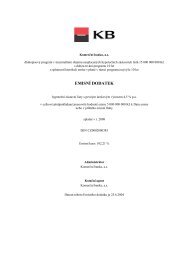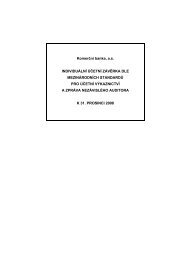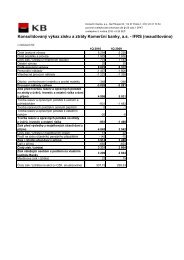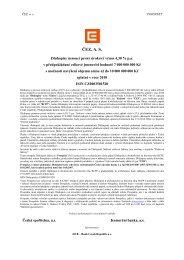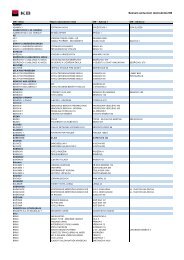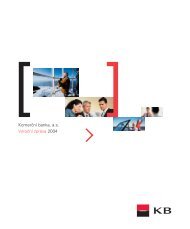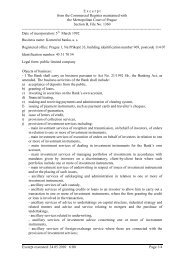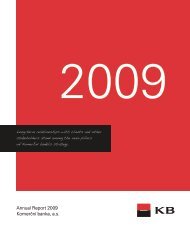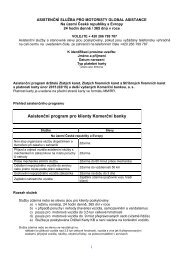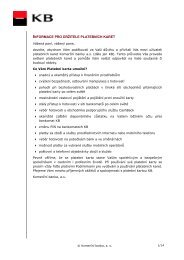KB prezent. angl - Komerční banka
KB prezent. angl - Komerční banka
KB prezent. angl - Komerční banka
You also want an ePaper? Increase the reach of your titles
YUMPU automatically turns print PDFs into web optimized ePapers that Google loves.
032 ➔033<br />
Report of the Board of Directors<br />
Monitoring of the CDO, CDS and CLN portfolio<br />
In 2003, the Bank sought to improve the methods and processes used for assessing CDO, CDS and CLN exposures. The tool<br />
used for the evaluation and for risk measurements of the portfolio is based on methodology that computes Monte-Carlo<br />
simulations of future cash flows depending on estimated credit deterioration of the underlying assets, and estimates the net<br />
present value of simulated (expected) cash flows. This model was also applied in the evaluation and risk assessment of credit<br />
default swaps and credit linked note transactions.<br />
Asset and Liability Management<br />
The process of asset and liability management (ALM) covers the core banking activities defined as the structural book and is<br />
driven by the need to address the potential consequences of any mismatches in the characteristics of assets and liabilities<br />
under management (interest rates, maturities, currency) and to pre-empt them. The rules used, changes to these rules, and<br />
proposed hedging transactions with respect to the interest rate and liquidity risk require the approval of the ALCO committee.<br />
In all its activities, the Bank complies fully with all requirements of the Czech regulatory authorities (the Ministry of Finance of<br />
the Czech Republic, the Czech National Bank), as well as with all international regulations (IAS 39).<br />
Liquidity risk<br />
The management of liquidity risk is primarily designed to ensure that the Bank can, at any time, meet its funding requirements.<br />
This includes the maintenance of adequate volumes of cash, and balances on nostro accounts and on the account of minimum<br />
mandatory reserves while keeping the Bank’s costs of liquidity low and not hindering business activities. Liquidity is maintained<br />
by consistent diversification of sources and cash-flow management as it reduces the occurrence of unforeseen requirements<br />
for additional funding in the period in question. This primary objective is achieved by way of managed coverage of the<br />
Bank’s cash-out with a very high confidence level (97.5%) over a sufficiently long future period (one year).<br />
A liquidity snapshot broken down by currency – CZK, USD, EUR and other currencies – is monitored on two levels of market<br />
behaviour: normal and stressed liquidity. The management of short-term inter-day liquidity is carried out using a series of<br />
indicators on a daily basis. Sufficient liquidity is controlled by means of a set of limits – in order to achieve these, the Bank<br />
uses on-balance sheet instruments (bond issues, loans taken, etc.) and off-balance sheet instruments (cross currency swaps,<br />
foreign exchange swaps).<br />
Structural interest rate and exchange rate risk<br />
Structural interest rate and exchange rate risks are risks of a potential loss arising from positions held in the Bank’s Structural<br />
Book as a result of a fluctuation in the market price (interest rate and exchange rate changes).<br />
Structural exchange rate risk is measured and managed on a daily basis. The Bank’s position is controlled by a system of<br />
limits (the Bank’s internal limits and limits required by the external regulator – the CNB). Foreign exchange positions are<br />
hedged by standard instruments (FX spot and FX forward operations).<br />
The Bank manages its structural interest rate risk using standard methods (gap analysis, interest rate sensitivity) and a more<br />
sophisticated method called Earnings at Risk, which is based on a stochastic evaluation of the volatility of future interest<br />
income. The Bank has implemented Convergence – an asset and liability management system supplied by SUNGARD.<br />
The system is used by ALM to apply methods for interest rate risk measurement combined with the goal of further<br />
reductions in risks. Standard market instruments for hedging against interest rate risk, such as interest rate swaps (IRS),<br />
forward rate agreements (FRA), and to a lesser degree investing in securities, are used by the Bank.



